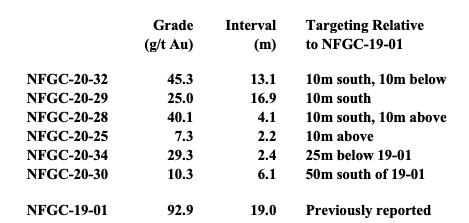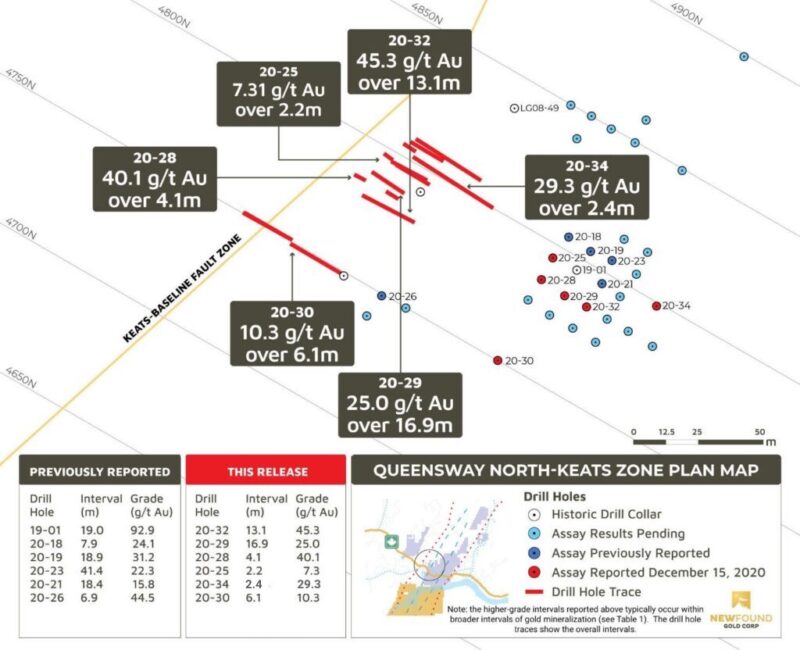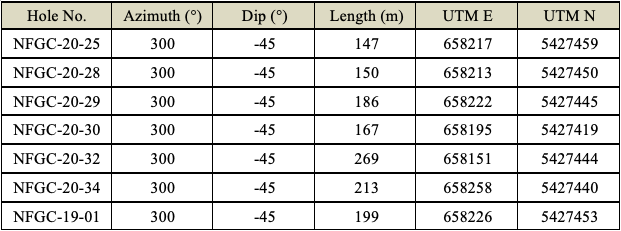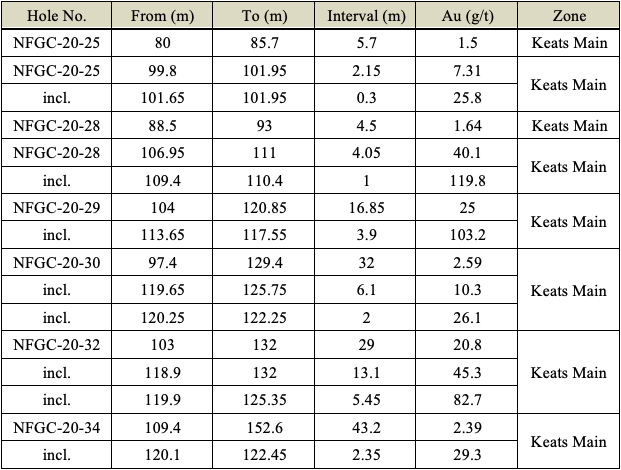New Found Gold Intercepts 45.3 g/t Au over 13.1m and 25.0 g/t Au over 16.85m in Step-Out Drilling at Keats Zone, Queensway Project, Newfoundland
Vancouver, BC, December 15, 2020: New Found Gold Corp. (“New Found” or the “Company”) (TSXV: NFG, OTC: NFGFF) is pleased to announce partial results from six additional holes drilled at the Keats Zone (“Keats”) drilled as part of the Company’ ongoing 100,000m diamond drill program at its 100% owned Queensway Project (“Queensway”), 15 km west of Gander, Newfoundland.
Highlights
- Intervals displaying significant quartz veining, sulfide mineralization and/or visible gold are assayed on a rush basis. Recent results received for six holes at Keats are summarized below and in Figure 1.

- These intervals reported above start at down-hole depths ranging from 80m to 132m.
- The interval reported in hole NFGC-20-30 is 50m south of NFGC-19-01 and is the second interval reported on this fence line. This intercept is approximately 50m vertically below the interval of 44.5 g/t Au over 6.85m previously reported in hole 20-26 (see November 16, 2020 news release).
- Intervals from holes completed 50m north of NFGC-19-01 (fence line 4850N) have been submitted on a rush basis and the Company anticipates reporting these results by early January.
- Of 36 holes completed to date at the Keats Zone the Company has now received full or partial results for 12 holes (including NFGC-19-01), including the six holes reported in this release. For other Keats Zone results please refer to the Company’s October 27 and November 16, 2020 news releases.
Greg Matheson, P.Geo., Chief Operating Officer of New Found, stated: “Veining observed in drill holes to date at Keats is characterized by quartz-sulfide mineralization displaying thicknesses typically in the 20m to 40m range with good continuity between holes. Intervals displaying visible gold have consistently been encountered within these broader vein intervals. Assays received to date have typically returned high-grade results albeit with some variability in thickness and grades likely due to the nugget effect. The Keats Zone has been confirmed by geophysics, surface sampling, and wide spaced drilling over more than 300m of strike and remains open along strike in both directions and to depth. Our current drill program continues to step-out and test this zone laterally and to depth.”


(note this is not intended to be representative of the gold mineralization in this hole)
Drill Collar and Interval Summaries


Table 1. Drill hole collar and interval summaries.
QA/QC
True widths of the new exploration intercepts reported in this press release have yet to be determined but are estimated to be 70% to 80% of reported core lengths. Assays are uncut, and calculated intervals are reported over a minimum length of 2 meters using a lower cutoff of 1.0 g/t Au. All HQ split core assays reported were obtained by either whole sample metallic screen/fire assay or standard 30-gram fire-assaying with ICP finish at ALS Minerals in Vancouver, British Columbia. The whole sample metallic screen assay method is selected by the geologist when samples contain coarse gold or any samples displaying gold initial fire assay values greater than 1.0 g/t Au. Drill program design, Quality Assurance/Quality Control and interpretation of results is performed by qualified persons employing a Quality Assurance/Quality Control program consistent with National Instrument 43-101 and industry best practices. Standards and blanks are included with every 20 samples for Quality Assurance/Quality Control purposes by the Company as well as the lab. Approximately 5% of sample pulps are sent to secondary laboratories for check assays.
Qualified Person
The technical content disclosed in this press release was reviewed and approved by Greg Matheson, P.Geo., Chief Operating Officer and a Qualified Person as defined under National Instrument 43-101.
About New Found Gold Corp
New Found holds a 100% interest in the Queensway Project, located 15 km west of Gander, Newfoundland, and just 18 km from Gander International Airport. The project is intersected by the Trans-Canada Highway and has logging roads crosscutting the project, high voltage electric power lines running through the project area, and easy access to a highly skilled workforce. With working capital of approximately C$61.5 million the Company is well financed for aggressive exploration with an initial planned drill program of 100,000 meters. New Found has a proven capital markets and mining team with major shareholders include Palisades Goldcorp (33%), Eric Sprott (18%), Novo Resources (11%), Rob McEwen (7%), other institutional ownership (8%), and management, directors and insiders (4%). Approximately 65% of the Company’s issued and outstanding shares are subject to escrow or 180-day lock up agreements.
Please see the Company’s website at www.newfoundgold.ca and the Company’s SEDAR profile at www.sedar.com.
Acknowledgments
New Found acknowledges the financial support of the Junior Exploration Assistance Program, Department of Natural Resources, Government of Newfoundland and Labrador.
Contact
To contact the Company please visit the Company’s website, www.newfoundgold.ca and make your request through our investor inquiry form. Our management has a pledge to be in touch with any investor inquiries within 24 hours.
New Found Gold Corp.
Per: “Craig Roberts“
Craig Roberts, P.Eng., Chief Executive Officer
Email: croberts@newfoundgold.ca
Phone: (604) 562 9664
Neither the TSX Venture Exchange nor its Regulation Services Provider (as that term is defined in the policies of the TSX Venture Exchange) accepts responsibility for the adequacy or accuracy of this release.
Forward-Looking Statement Cautions:
This press release contains certain “forward-looking statements” within the meaning of Canadian securities legislation, relating to further the exploration and drilling on the Company’s Queensway gold project in Newfoundland. Although the Company believes that such statements are reasonable, it can give no assurance that such expectations will prove to be correct. Forward-looking statements are statements that are not historical facts; they are generally, but not always, identified by the words “expects,” “plans,” “anticipates,” “believes,” “intends,” “estimates,” “projects,” “aims,” “potential,” “goal,” “objective,” “prospective,” and similar expressions, or that events or conditions “will,” “would,” “may,” “can,” “could” or “should” occur, or are those statements, which, by their nature, refer to future events. The Company cautions that Forward-looking statements are based on the beliefs, estimates and opinions of the Company’s management on the date the statements are made and they involve a number of risks and uncertainties. Consequently, there can be no assurances that such statements will prove to be accurate and actual results and future events could differ materially from those anticipated in such statements. Except to the extent required by applicable securities laws and the policies of the TSX Venture Exchange, the Company undertakes no obligation to update these forward-looking statements if management’s beliefs, estimates or opinions, or other factors, should change. Factors that could cause future results to differ materially from those anticipated in these forward-looking statements include risks associated possible accidents and other risks associated with mineral exploration operations, the risk that the Company will encounter unanticipated geological factors, the possibility that the Company may not be able to secure permitting and other governmental clearances necessary to carry out the Company’s exploration plans, the risk that the Company will not be able to raise sufficient funds to carry out its business plans, and the risk of political uncertainties and regulatory or legal changes that might interfere with the Company’s business and prospects. The reader is urged to refer to the Company’s reports, publicly available through the Canadian Securities Administrators’ System for Electronic Document Analysis and Retrieval (SEDAR) at www.sedar.com for a more complete discussion of such risk factors and their potential effects.